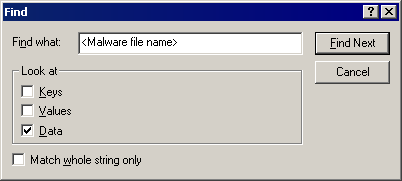TROJ_VUNDO.KSX
Trojan:Win32/Vundo.gen!G (Microsoft); Trojan.Win32.Monder.cync (Kaspersky); Vundo.gen.ab (McAfee); Troj/Virtum-Gen (Sophos); Trojan:W32/Vundo.TD (FSecure); Packed.Win32.Vundo.b (Sunbelt); W32/Vundo.fam!tr (Fortinet); Worm.Win32.Vundo (Ikarus)
Windows 2000, Windows XP, Windows Server 2003


Threat Type: Trojan
Destructiveness: No
Encrypted: Yes
In the wild: Yes
OVERVIEW
This Trojan arrives on a system as a file dropped by other malware or as a file downloaded unknowingly by users when visiting malicious sites.
TECHNICAL DETAILS
Arrival Details
This Trojan arrives on a system as a file dropped by other malware or as a file downloaded unknowingly by users when visiting malicious sites.
Autostart Technique
This Trojan adds the following registry entries to enable its automatic execution at every system startup:
HKEY_CLASSES_ROOT\CLSID\{random CLSID}\
InprocServer32
{default} = "{malware path}\{malware name}.dll"
HKEY_LOCAL_MACHINE\SOFTWARE\Classes\
CLSID\{random CLSID}\InprocServer32
{default} = "{malware path}\{malware name}.dll"
HKEY_LOCAL_MACHINE\SOFTWARE\Microsoft\
Windows\CurrentVersion\Run
{random name} = "Rundll32.exe "{malware path}\{malware name}.dll",a"
Other System Modifications
This Trojan adds the following registry entries as part of its installation routine:
HKEY_CLASSES_ROOT\CLSID\{random CLSID}\
InprocServer32
ThreadingModel = "Both"
HKEY_LOCAL_MACHINE\SOFTWARE\Classes\
CLSID\{random CLSID}\InprocServer32
ThreadingModel = "Both"
HKEY_LOCAL_MACHINE\SOFTWARE\Microsoft\
Windows\CurrentVersion\Explorer\
SharedTaskScheduler
{random CLSID} = "jugezatag"
HKEY_LOCAL_MACHINE\SOFTWARE\Microsoft\
Windows\CurrentVersion\ShellServiceObjectDelayLoad
{random name} = "{random CLSID}"
HKEY_LOCAL_MACHINE\SOFTWARE\Microsoft\
Windows NT\CurrentVersion\Windows
LoadAppInit_DLLs = "1"
It modifies the following registry key(s)/entry(ies) as part of its installation routine:
HKEY_LOCAL_MACHINE\SOFTWARE\Microsoft\
Windows NT\CurrentVersion\Windows
AppInit_DLLs = "{malware path}\{malware name}.dll"
(Note: The default value data of the said registry entry is {blank}.)
It adds the following registry keys as part of its installation routine:
HKEY_CLASSES_ROOT\CLSID\{random CLSID}
HKEY_CLASSES_ROOT\CLSID\{random CLSID}\
InprocServer32
HKEY_LOCAL_MACHINE\SOFTWARE\Classes\
CLSID\{random CLSID}
HKEY_LOCAL_MACHINE\SOFTWARE\Classes\
CLSID\{random CLSID}\InprocServer32
SOLUTION
Step 1
For Windows XP and Windows Server 2003 users, before doing any scans, please make sure you disable System Restore to allow full scanning of your computer.
Step 2
Restart in Safe Mode
Step 3
Delete the created random CLSID key
Important: Editing the Windows Registry incorrectly can lead to irreversible system malfunction. Please do this step only if you know how or you can ask assistance from your system administrator. Else, check this Microsoft article first before modifying your computer's registry.
Step 4
Delete this registry value
Important: Editing the Windows Registry incorrectly can lead to irreversible system malfunction. Please do this step only if you know how or you can ask assistance from your system administrator. Else, check this Microsoft article first before modifying your computer's registry.
- In HKEY_LOCAL_MACHINE\SOFTWARE\Microsoft\Windows\CurrentVersion\Run
- {random name} = "Rundll32.exe "{malware path}\{malware name}.dll",a"
- {random name} = "Rundll32.exe "{malware path}\{malware name}.dll",a"
- In HKEY_LOCAL_MACHINE\SOFTWARE\Microsoft\Windows\CurrentVersion\Explorer\SharedTaskScheduler
- {random CLSID} = "jugezatag"
- {random CLSID} = "jugezatag"
- In HKEY_LOCAL_MACHINE\SOFTWARE\Microsoft\Windows\CurrentVersion\ShellServiceObjectDelayLoad
- {random name} = "{random CLSID}"
- {random name} = "{random CLSID}"
- In HKEY_LOCAL_MACHINE\SOFTWARE\Microsoft\Windows NT\CurrentVersion\Windows
- LoadAppInit_DLLs = "1"
- LoadAppInit_DLLs = "1"
Step 5
Restore this modified registry value
Important: Editing the Windows Registry incorrectly can lead to irreversible system malfunction. Please do this step only if you know how or you can ask assistance from your system administrator. Else, check this Microsoft article first before modifying your computer's registry.
- In HKEY_LOCAL_MACHINE\SOFTWARE\Microsoft\Windows NT\CurrentVersion\Windows
- From: AppInit_DLLs = "{malware path}\{malware name}.dll"
To: AppInit_DLLs = ""
- From: AppInit_DLLs = "{malware path}\{malware name}.dll"
Step 6
Scan your computer with your Trend Micro product to delete files detected as TROJ_VUNDO.KSX. If the detected files have already been cleaned, deleted, or quarantined by your Trend Micro product, no further step is required. You may opt to simply delete the quarantined files. Please check this Knowledge Base page for more information.
Did this description help? Tell us how we did.


